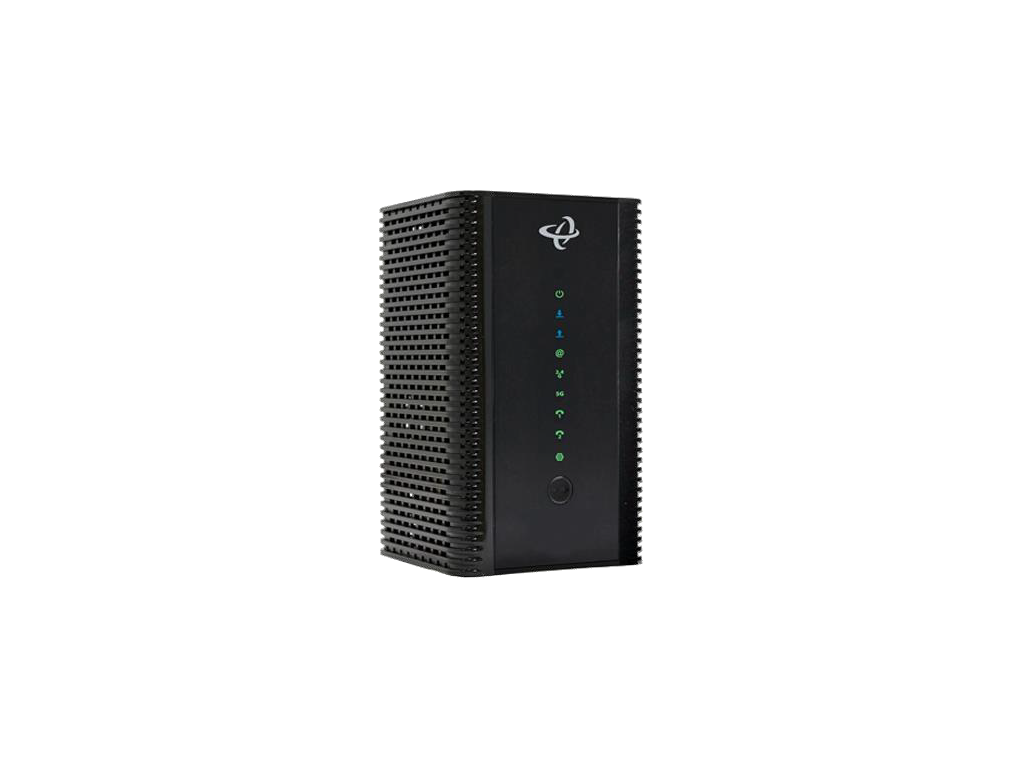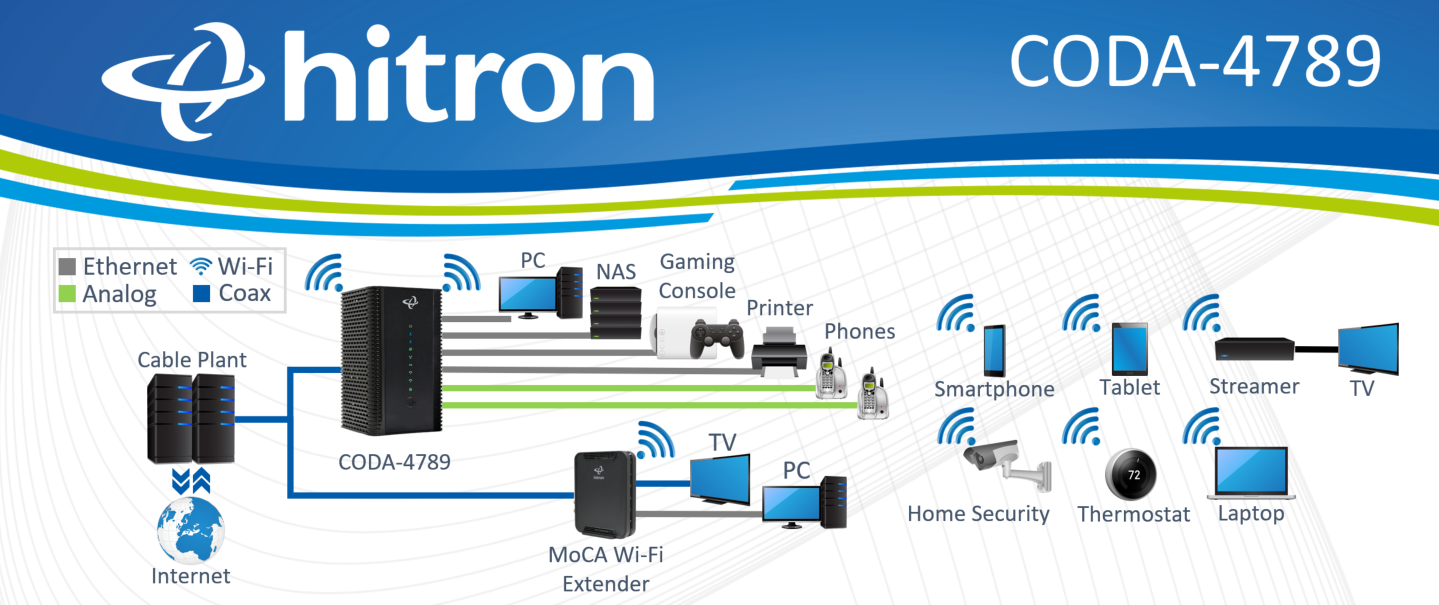High-Performance Hub for Multi-Gigabit Internet Services and Voice
Multi-Gigabit speeds. Ultra-HD video streaming. High-speed networking. Telephony support. The CODA-4789 Cable Modem Router can do it all. With DOCSIS 3.1 (speeds up to 10 Gbps* downstream) and 802.11ac Wave 2 Wi-Fi speeds up to 2.3 Gbps, the CODA-4589 cable gateway is a powerful hub for every home and small business networking need. You get multi-Gigabit speeds and the power of six devices in one.
Software-switchable Frequency
Upgrade to the high-split (5-204MHz) return path to meet the increased upstream bandwidth demands of video conferencing, IoT and interactive services. Further, since you can change this feature remotely, you have eliminated the need to swap out hardware or send out a technician.
DOCSIS 3.1 Certified
DOCSIS 3.1 takes Internet speeds to a new level, increasing the capacity of HFC networks by more than 50 percent and reducing latency. This means your customers can connect more devices, enjoy richer digital experiences, and get fast, reliable Internet service for all of today and tomorrow’s needs.
Six Devices in One
The CODA-4789 integrates six products into a single device: a multi-gigabit DOCSIS 3.1 modem, a home router with four Gigabit Ethernet ports for blazing fast wired connections, an 802.11ac dual-band access point for superior wireless coverage and speed, integrated MoCA 2.0 for a super-fast home backbone, two HD voice ports for telephony applications and a DLNA Media Server for video, audio and image serving.
Blazing Fast Wi-Fi Everywhere in the House
Gigabit Internet service demands powerful in-home Wi-Fi. The CODA-4789 offers integrated 3×3 2.4 GHz 802.11n and 4×4 5 GHz 802.11ac Wave 2 dual-band concurrent MU-MIMO access points for superior coverage and a blazing fast, lag-free Wi-Fi experience. And with support for 802.11ac Wave 2, you get more than just ultra-fast wireless. Users will notice better performance when multiple devices are running apps simultaneously, higher signal quality and dependability.
Superior Coverage with Bonded MoCA 2.0
With integrated MoCA support, customers can easily extend their home Wi-Fi network throughout the home. MoCA 2.0 bonding provides a near-Gigabit wired backbone over the home’s existing coax wiring. And Hitron’s AutoSync software provides secure automated setup of Hitron MoCA extenders.
Four Wired Gigabit Ethernet Ports
Four Gigabit Ethernet ports offer ultra-fast, reliable wired connections for the home theater or home office.
Compatible with DOCSIS 3.0
The CODA-4789 can be deployed on your current network. As a DOCSIS 3.0 modem, it offers 32 bonded downstream and 8 bonded upstream channels. When you upgrade the network to DOCSIS 3.1, you won’t need to swap out customer hardware.
Easy to Setup and Manage
Installation is a snap for your end users. The built-in TFTP client automatically gets the IP address and configuration data from the network server. That means a few simple connections is all it takes to get up and running. The CODA-4789 supports pre-configured and pre-enabled Wi-Fi security via WiFi Protected Setup (WPS), allowing end users to rapidly setup a secure wireless network without manual configuration. And SNMP, TR-069 and HNAP support provide total remote control over the device for fast and effective troubleshooting.
Key Specifications
- DOCSIS 3.1 compliant
- DOCSIS 3.1 2×2 multi-carrier OFDM
- DOCSIS 3.0 32×8 channel bonding
- Switchable 5-85/5-204MHz Upstream
- Wi-Fi 3×3 2.4 GHz 802.11n and 4×4 5 GHz 802.11ac Wave 2 dual band MU-MIMO
- MoCA 2.0 Channel Bonding for highest performance
- One USB 3.0 host, supporting Network Attached Storage (NAS) functionality
- Integrated DLNA Media Server with support for video, audio and image serving
- 2 HD voice ports with SIP or MGCP support
- Battery backup (BBU)
- Extensive operator control via configuration file and SNMP
- TR-069 and HNAP for easy setup and remote management
Learn More about Cable Modems & Routers
WPS on Router: What It Is and Why It Might Not Be Safe
What Is WPS on a Router? WPS (WiFi Protected Setup) is a feature that helps devices connect to a WiFi network without entering a password. It’s often found as a button on the back or side of routers. When you press it, the router enters a short 1–2 minute window where...
When Should I Reset vs Restart my Cable Modem?
When you should do a cable modem restart or reset depends on the situation. It’s extremely important to understand these terms as the function of these terms have different meanings. In simple terms, to restart or reboot your modem means to turn off your modem and...
What is WiFi 6 and Is WiFi 6 Really Better?
WiFi 6 (also known as 802.11ax) is the most recent version of WiFi. It’s the best version of WiFi to date, with more support, faster speeds, less network congestion, better security, improved battery life for devices, and more. If you are looking for the latest and...
How do I set up my cable modem?
There are differences in setting up your cable modem whether you purchased or rented the device. If you bought your own cable modem, you should check the user manual or manufacturers' support website for specific details. For example, Xfinity (Comcast) and other Cable...
Can I use any cable modem for Cable Internet?
The right cable modem or cable modem router combo to use to get cable Internet in your home depends on a few things: Whether you are renting vs buying Certification and compatibility with your Service Provider Must-have features to consider For example, if your...

